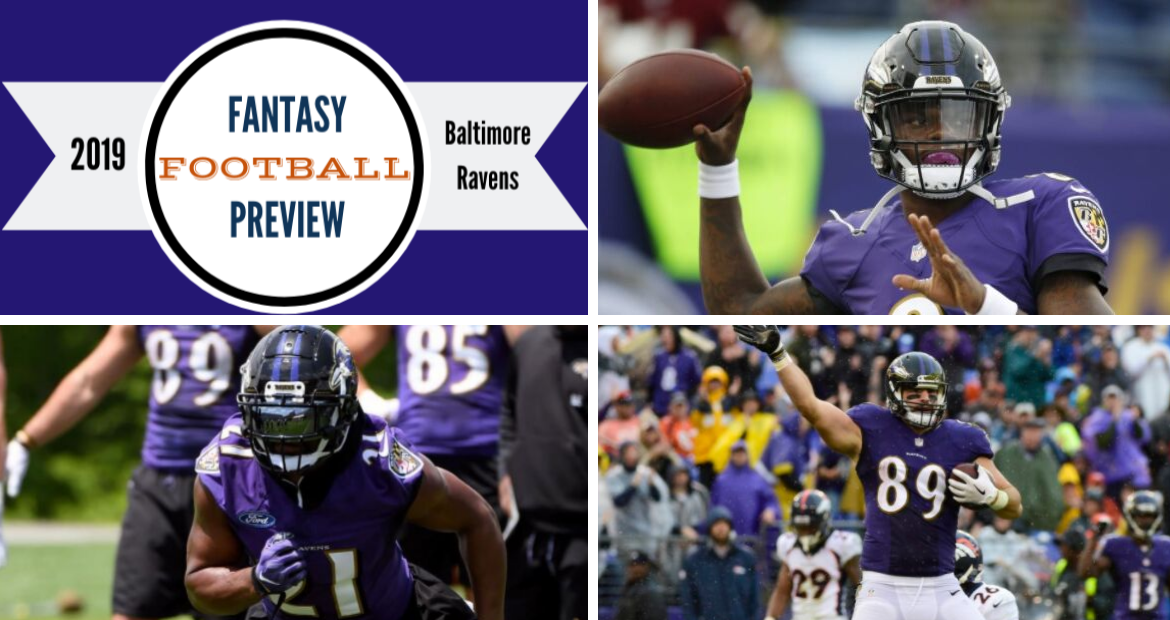
Fitz on Fantasy: 2019 Baltimore Ravens Buying Guide
With the preseason nearing, TFG fantasy expert Pat Fitzmaurice is breaking down the prospects for all 32 teams. Click here for a running list of teams, and check back often as teams are added on an almost daily basis. On to the Baltimore Ravens…
Lamar Jackson is bargain-priced right now, and it’s because a lot of people believe the Baltimore offense will look much the same as it did after Jackson became the starter a little over halfway through the 2018 season. In the Ravens’ last seven regular-season games, Jackson averaged 22.6 passing attempts and 17.0 rushing attempts per game. The offense was based largely on run-pass options, but often the “P” disappeared from “RPO,” and the offense too often became a simple mixture of Jackson keepers and inside handoffs to Gus Edwards.
The Ravens aren’t going to morph into the “Greatest Show on Turf” Rams or the “Air Coryell” Chargers, but no team with serious designs on the Lombardi Trophy can get away with running a glorified high school offense. The front office seemed to be acknowledging that when it selected wide receivers in the first and third rounds of this year’s draft.
Jackson is never going to be a pinpoint passer – that simply isn’t his game – but what if Jackson can combine the sort of rushing numbers that Michael Vick produced in the Atlanta phase of his career with the sort of reasonably competent passing ability that Vick developed during the Philadelphia phase of his career? Well, we’d be cooking with gas, wouldn’t we
Jackson’s rookie passing numbers weren’t pretty (58.2% completion rate, 7.1 yards per pass attempt, six TDs, three INTs), but his passer rating (84.5) was better than Joe Flacco’s rookie-year passer rating and better than any single-season passer rating Vick posted during his Atlanta years.
Ravens offensive coordinator Greg Roman was working as the 49ers’ coordinator in 2013-2014 when versatile run-pass threat Colin Kaepernick turned in QB9 and QB16 fantasy seasons, and Roman coordinated the Bills’ offense in 2015-2016, when Tyrod Taylor finished QB16 and QB8. Kaepernick and Taylor never failed to throw for 3,000 yards in four combined seasons under Roman.
Jackson might be the best running quarterback of all time. He averaged 4.7 yards per carry last year and had five TD runs – deceivingly modest numbers. With fewer designed runs and more organic scrambling, Jackson could come close to the 7.1 yards per carry that Josh Allen averaged for the Bills last year. Ideally, Jackson runs a little less and throws more. If Roman ratchets up the passing volume just a bit, and if Jackson can fine-tune his mechanics, a 3,000-yard passing season and 1,000-yard rushing season is within his range of outcomes.
Jackson’s primary backup is Robert Griffin III, and while RG3 was briefly a phenom after entering the league in 2012, he poses no threat to Jackson’s job security. But if Jackson were to go down, RG3 might be worth a waiver claim as sort of a Jackson Lite.
The Ravens spent considerable draft capital at wide receiver this spring, yet their WR stable isn’t exactly brimming with talent. A cupboard that last year looked like Mother Hubbard’s now looks like that of a college student with a part-time job of the student union – a few packets of ramen noodles, some soup, maybe a couple of cans of chili.
Baltimore’s first-round pick, Marquise “Hollywood” Brown, was a 2,000-volt playmaker at Oklahoma, but he’s coming off a Lisfranc injury that might keep him sidelined for part of training camp, and he weighs only 170 pounds. There have been 13 instances of a receiver weighing 170 pounds or less producing a 1,000-yard season during the Super Bowl era, and the only receivers to have done it more than once are Cliff Branch, Anthony Carter, Drew Hill and Alfred Jenkins. Trying to tackle Brown is like trying to tackle strobe lighting, but his physical profile is eerily similar to that of Tavon Austin, whose fantasy contributions over six NFL seasons can be measured in teaspoons. I’m out on Brown, at least in Year One.
The Ravens took Miles Boykin of Notre Dame in the third round of the draft. He’s a more traditional WR prospect than Brown, standing 6-4 and weighing 228 pounds. Boykin’s athletic profile is eye-opening – he has 4.42 speed and a 94th percentile SPARQ-x score – but his college production was ordinary, and he’ll need to be coached up. An unvarnished WR prospect in a run-heavy offense isn’t a great bet in redraft leagues.
Willie Snead had 141 catches and 1,879 yards during the first two years of his three-year run with the Saints, though he’s scored only eight touchdowns in 57 career games. He fell out of favor in New Orleans after serving a three-game suspension following a DUI arrest, signed with the Ravens and had a team-high 62 catches (though he averaged 10.5 yards per catch and scored only one touchdown). It’s possible that Snead might average five or six targets in this run-heavy offense, but since Snead is a short-area receiver, those would be low-value targets. He looks like more of an any-port-in-a-storm waiver option than an appealing late-round choice.
Chris Moore, Seth Roberts, Jordan Lasley, Jaleel Scott and Michael Floyd are among the receivers fighting for roster spots.
It’s puzzling why the Ravens took Hayden Hurst ahead of Mark Andrews in the 2018 draft, but the Baltimore faithful should be grateful that the team’s front office pulled a George Costanza and double-dipped at the position.
The 23-year-old Andrews is two years younger than Hurst, has a nearly identical athletic profile and was far more productive than Hurst in college. Rookie tight ends rarely produce useful fantasy numbers, but Andrews squeezed out 552 yards and three TDs despite Baltimore’s heavy run tilt, with 28 of his 34 catches producing first downs. You’d think that Andrews would have been more productive playing with Joe Flacco than with Lamar Jackson, especially considering Flacco’s fondness for his tight ends, but Andrews accumulated 55.8% of his receiving yardage in the seven games Jackson started.
With an ADP of TE22, Andrews isn’t getting much love in early drafts, and at such a deep discount, he’s one of my favorite TE targets.
Hurst had 13 catches in 12 games during a rookie season that was interrupted by a foot injury. He’s also been dealing with a hamstring injury but is expected to be ready for camp. Hurst has an ADP of TE30, but I can’t understand why you’d take Hurst in a deep draft unless you’re convinced that Andrews’ rookie performance wasn’t a complete mirage.
It’s weird to have to project Mark Ingram’s performance anywhere but in New Orleans, where he spent the first eight years of his career. The Ravens signed Ingram to a three-year deal in free agency, and the nature of this offense suggests that Ingram has a reasonable chance to eclipse his single-season high of 230 carries. Ingram has been an efficient runner over the last five years, averaging 4.7 yards per carry over that span, with 39 TD runs in 69 games. And hell, maybe he could be even MORE efficient in an offense like this one, where Jackson’s mobility can help make the holes in the defense a little bigger.
Ingram was used sparingly in the passing game early in his stint with the Saints, but his role as a receiver evolved, and he averaged 51.3 catches a year from 2015 to 2017. Jackson didn’t throw to his running backs very often last season, and in a run-heavy offense with a mobile quarterback, there shouldn’t be much optimism for Ingram’s pass-catching contributions.
With an ADP of RB23, Ingram looks like a solid value, but he’ll obviously be more valuable in standard leagues than in full-point PPR leagues.
Gus Edwards came into the league with almost zero college pedigree, but he was the mutt you fell in love with at the Humane Society and just had to take home. A waiver-wire darling last fall, Ravens ran for 718 yards in only 11 games and averaged 5.2 yards per carry. At 6-1 and 238 pounds, Edwards fit the running scheme well, hitting holes decisively and powering through arm tackles. With only two catches, Edwards lost some value in PPR leagues, but since he averaged 17.4 carries in Jackson’s seven starts, no one was complaining much about the minimal passing-game productivity.
Edwards’ lack of pedigree isn’t the issue this year. The problem is that Ingram is now the alpha dog, and it’s possible that Edwards might not even be the No. 2 guy in this backfield. That role uncertainty renders Edwards undraftable in all but the deepest of leagues.
As the speediest running back by far in a run-heavy offense, Justice Hill might have the clearest path to carries than any of the rookie RBs outside the Josh Jacobs/David Montgomery/Miles Sanders troika. Hill has 4.4 speed and was productive during all three of his seasons at Oklahoma State. At 5-10 and 200 pounds, the waifish Hill might not be able to withstand a heavy workload, but there should be plenty of work to go around in this offense. He’s an enticing mid- to late-round dart throw.
Is the show over for Kenneth Dixon in Baltimore? There are Dixon truthers still keeping candles lit, but injuries and suspensions have kept the intriguing Louisiana Tech prospect from gathering any sort of career momentum. And that was when there was relatively little positional competition. Now, Dixon might be logjammed. The truthers might have been able to walk away if Dixon hadn’t run for 117 yards in only 12 carries in the Ravens’ 2018 regular-season finale against the Browns. That performance is why they’re still meeting in a church basement on Wednesday nights, drinking lukewarm coffee and concocting implausible narratives to support a 2019 Dixon breakout.
| PLAYER | FITZ RANK | ECR | ADP | ADVICE |
| Lamar Jackson | QB11 | QB17 | QB19 | Buy, buy, buy |
| Mark Ingram | RB22 | RB22 | RB22 | Fairly valued |
| Justice Hill | RB48 | RB59 | RB55 | Dart throw |
| Marquise Brown | WR79 | WR79 | WR59 | Too soon |
| Willie Snead | WR95 | WR89 | WR99 | Pass |
| Mark Andrews | TE14 | TE20 | TE22 | Grab him |
ADP = Average Draft Position ECR = Expert Consensus Ranking (based on half-PPR scoring)



